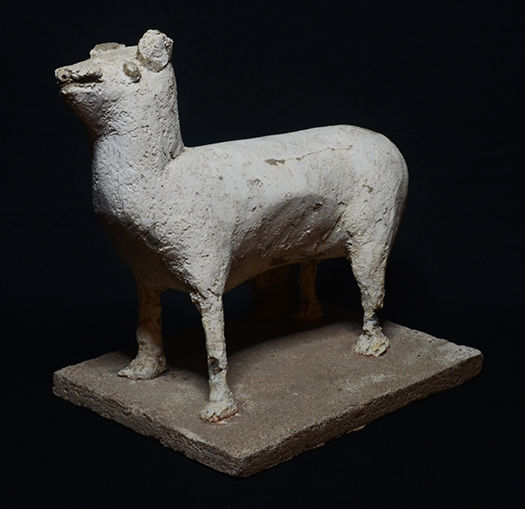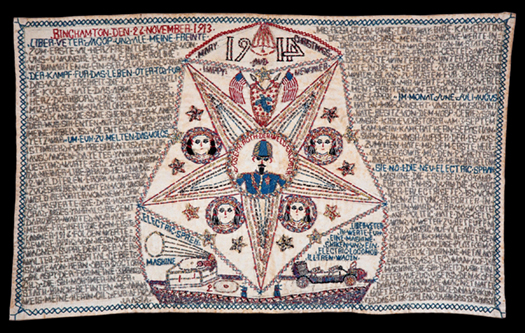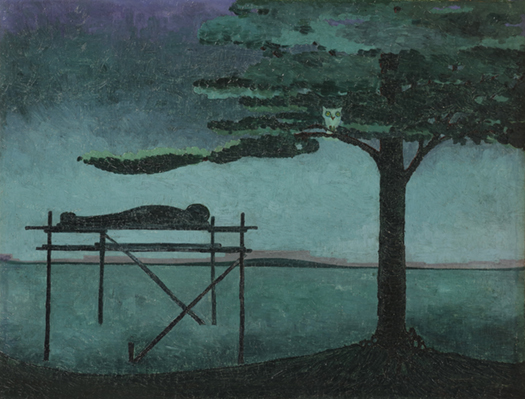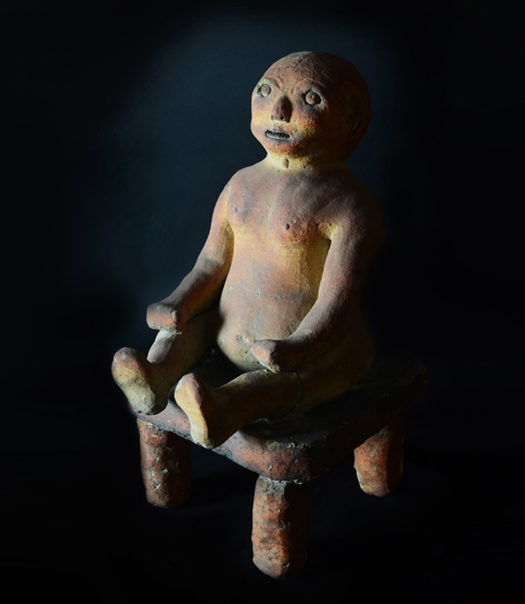- HOME
- INVENTORY
- GALLERY
- BOOKS
- CATALOGS
- ABOUT & MORE
- CONTACT
Contact Us
About: Steven S. Powers
Interviewed By Jennifer Gilbert of Jennifer Lauren Gallery
LINK to source page.JG: When did your interest in the field of outsider/folk art begin?
SP: I didn’t have an “a-ha” moment or epiphany, but I know folk art sculpture came to me first and quite a bit later folk art painting, and then what we would say Outsider Art came after that. I started out collecting 17th and 18th century American and European treen or woodenware, which often encompassed what we would call folk art carving. So I was first a fanatic for wood and more so wood with a complex surface or patina. This led me to Woodlands Indian Art, which often has a mastery of form, proportions, and precise execution of craft—while not folk art per se, it helps illustrate my aesthetic interests, and there are certainly overlaps.JG: When did you become a collector of this art? How many pieces do you think are in your collection now? And do you exhibit any of it on the walls of your home or elsewhere?
SP: I started seriously collecting right out of college. I had no money, but I was compelled to buy and learn more from dealers and books. It was a consuming obsession. I have always lived with art — a lot of it. I have a terrible out-of-sight, out-of-mind complex when it comes to things like this, so I have to see it all, all the time. Our apartment is filled from floor-to-ceiling with paintings and sculpture with some overflow to my painting studio nearby in Red Hook, Brooklyn.

Dilmus Hall (1900-1987) | Lamb | Concrete, rebar, paint | Circa: 1960
JG: ‘Steven S Powers: Works of Art and Americana’ is a Gallery you set up in 1996. It says online that you sell: American Folk and Outsider Art, Woodlands sculpture (Northeast Native American), treen and choice antiques – this is quite a diverse mix, can you tell us more about these choices?
SP: It has all been an evolution — not a business model. On the surface, it appears diverse, but it’s highly focused— narrow within a broad range. Because I am a dealer, I buy as if I were a collector and sell my acquisitions on a rotating basis — each sale funds the next purchase and so on and so forth.JG: You have written a book too, can you tell us about this?
SP: I wrote ‘North American Burl Treen: Colonial & Native American’ in 2005. When I became interested in this material in the early 90s, there were no books to turn to. There was a 40 page, black and white booklet, and some miscellaneous examples sited in various publications, but nothing cohesive or comprehensive. So I wrote the book that I wish existed when I first became interested in that material. I also wrote the ‘Woodlands Indian Art volume of Art of The Spirit World’.JG: Alongside being a dealer and collector, you are also an artist - do you still create art, and what made you move from being an artist to the other two roles?
SP: Yes, I am a painter. I became a dealer so I could afford a New York studio. I figured dealing would bank role that rent. Or so that was the original plan, but it didn’t exactly happen that way. I became thoroughly interested in buying and selling. I got married, had kids, wrote the burl book, and then another book and painting got away from me. However, in 2013, I rented a painting studio in Red Hook, Brooklyn, and have been back at it with earnest since. Giampietro Gallery represents my work as a painter.
Joseph Roth (1851? - 1921) | Binghampton, NY | Embroidery on pillow case | Circa: 1913
JG: What is it that draws your eye away from contemporary art to outsider/folk art? Or do you collect both?
SP: I am open to anything that gets my aesthetic itch activated. It’s the quality and execution of vision and voice that I am looking for. I cannot collect everything, but I can appreciate and learn from what stirs me and figure out how I can apply it to what I am doing as a dealer and/or as a painter.JG: What style of work, if any, is of particular interest to you within this field? (for example is it embroidery, drawing, sculpture, and so on).
SP: It is hard to say if I have a preference for a particular medium, as I have been elated by examples in all mediums, however one medium that personally surprises me the most is embroidery. I love a great embroidered work — I always find them unexpectedly successful when they cross from craft into art.JG: Would you say you had a favourite artist or piece of work within your collection? And why?
SP: I had a painting a few years ago by an obscure Chickasaw painter, Frank Overton Colbert, circa 1922 — it was an image that blew me away when I first saw it. It was entirely revelatory and unlike anything I had seen before. I knew within a fraction of a second it was a masterpiece, and I would sell my kids to own it. I didn’t have to sell my kids, but I did acquire it and lived with it for a bit and then sold it. As a dealer, I find it a conflict of interest to collect what I deal with, so everything is for sale.
Frank Overton Colbert (Chickasaw 1895-1953), The Trail to Happy Hunting Ground, Circa: 1922.
JG: Where would you say you buy most of your work from a studio, art fairs, exhibitions, auctions, or direct from artists?
SP: In over 25 years, I still have not figured out how things exactly come my way. I mean, I am continually looking (it occupies most of my time). I look at things other dealers have, I get solicitations from collectors looking to downsize, randos from the internet, and of course, I look at auctions as well. But, I prefer to buy privately.JG: I believe that since 2017 you have produced catalogues to go alongside your booth at the Outsider Art Fair in New York – is this correct? And why did you make this choice?
SP: Yes, for most major fairs, including the Outsider Art Fair, I produce a catalog. Besides obvious marketing reasons, I mainly create the catalogs to get to know the pieces better. By photographing and writing about them, it is how I absorb what they are about and hopefully learn their secrets — learn what makes them successful works of art.JG: A conflicted term at present, but can you tell us about your opinion of the term outsider art, how you feel about it and if there are any other words that you think we should be using instead?
SP: It is a term that attempts to label the artist/creator and not the art itself, which is a shaking starting point, so yeah, it is an imperfect term for sure. But, one that is sticking, or as Malcolm Gladwell would say, “is sticky.” There might not be anything that we can do about it at this point. My friend and I were talking the other day about the term “Indian,” not as a politically incorrect term, but as something that is amazingly inaccurate and was known to be inaccurate quite early on but stuck.JG: Is there an exhibition in this field of art that you have felt has been particularly important? And why?
SP: Alfred Barr, a former director of MOMA, mounted a couple of important shows early on; the William Edmondson exhibit in 1937, and the Masters of Popular Painting show in 1938. Skipping ahead, the 1980 exhibition at The Corcoran Gallery, Black Folk Art, was groundbreaking. And most recently, Outliers and American Vanguard at the National Gallery, which, in some respects, combined the previous aforementioned exhibits.
Terracotta Toddler, Architectural earthenware, Circa: 1920, Size: 12" (w) x 15" (d) x 24" (h)
JG: Are there any people within this field that you feel have been particularly important to pave the way for where the field is at now?
SP: Yes, the grandfathers, Alfred Barr, Holger Cahill, Dr Prinzhorn, and Sidney Janis, and then another generation by the likes of Phyllis Kind, Luise Ross, Ricco-Maresca, Carl Hammer, Hill Gallery, Shari Cavin and Randall Morris of Cavin-Morris Gallery, and Aarne Anton of American Primitive Gallery to name a few off the top of my head.JG: Is there anything else you would like to add?
SP: Yes, I wish that those that collect Outsider Art had more confidence in anonymous and newly discovered art. In that, I find fair-goers at The Outsider Art Fair, at first blush, progressive and adventurous in their aesthetic pursuits, but when it comes down to it, they are very conservative buyers and often buy by name alone. I fear the market will become geared towards name brands and blue-chip artist, and oriented like the Fine Art market. Because I bridge the antiques and art worlds, I have seen collectors on both sides, and somewhat surprisingly, I have found that antiques collectors are often more adventurous buyers. Outsider Art collectors need to loosen up a bit, trust their gut, and buy the art, not the artist.Powers is a cycling enthusiast and his passions for art and cycling have come together in this remarkable handmade bike (click here).

Our Guarantee:
All objects are guaranteed as represented. Please contact me within three days of receipt if there is an issue with the item or wish to return it. Otherwise all sales are final. Refunds are only given on items that were paid in full at the time of purchase—not over time.
• • • •

Payment Options:
Personal checks or credit cards (MasterCard, Visa, American Express & Discover).
Payment Plans: Just ask—we will be happy to work with you.
• • • •
Professional Affiliations:
Antiques Dealers' Association of America (ADA)
Founded 1984
Current Vice President
STEVEN S. POWERS • 53 STANTON ST, NY, NY 10002 • 917-518-0809 • email: steve@stevenspowers.com • © all rights reserved
